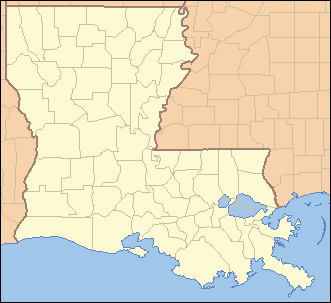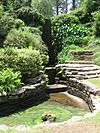List of Louisiana state parks facts for kids
 |
| Map of state parks maintained by the Office of State Parks (Each dot is linked to the corresponding park article) |
Louisiana is home to 38 amazing state parks! These parks are special places managed by the Office of Lieutenant Governor, which is part of the Louisiana Department of Culture, Recreation and Tourism. They offer fun and adventure for everyone.
The idea for Louisiana's state park system started way back in 1934. That's when a special group called the State Parks Commission of Louisiana was created. Later, in 1952, this group's job grew to include creating more outdoor activities and places for people to enjoy. It was then renamed the Louisiana State Parks and Recreation Commission. Finally, in 1977, the Office of State Parks was formed to specifically manage these wonderful natural areas.
After the State Parks Commission started in 1934, seven new park sites were added. During World War II, fewer new parks were added, with only one, Sam Houston Jones State Park, joining in 1944. In 1966, the National Park Service looked at Louisiana's state parks and gave many ideas on how to make them even better. This led to clear rules for what a state park should be. Because of these new rules, some places that didn't quite fit were changed into state historic sites or given to local groups to manage. Some of these included Lac des Allemands, Saline Bayou, and Black Lake.
In the 1970s, the way the state parks were managed changed again, and the Office of State Parks was officially created. Two new parks were also added during this time. From 1995 to 2009, a lot of money (about $80 million!) was spent to build new things or update older facilities in the parks.
Louisiana state parks are chosen because they are beautiful natural areas with unique scenery. Many of them also have important history or scientific value. For example, Chemin-A-Haut State Park was once a path used by Native Americans when they traveled during different seasons.
These parks offer many cool things to do! You can stay overnight in cabins, rent boats, take guided tours, and fish from piers. In 2002, more than 2 million people visited Louisiana's state parks! With the addition of Palmetto Island State Park in 2010, all the state parks together cover more than 30,000 acres (about 12,000 football fields!) of land.
Contents
Explore Louisiana's Current State Parks
| Park Name | Parish | Size | Year Established | What Makes It Special | Image |
|---|---|---|---|---|---|
| Bayou Segnette State Park | Jefferson Parish | 676 acres (274 ha) | 1987 | This park has a fun wave pool! | |
| Bogue Chitto State Park | Washington Parish | 1,786 acres (723 ha) | 2010 | Bogue Chitto (say it: bo–guh chit–uh) has 14 miles (23 km) of trails for horse riding, starting near Fricke's Cave. | |
| Chemin-A-Haut State Park | Morehouse Parish | 503 acres (204 ha) | 1935 | This park was designed with kids in mind and has two playgrounds! | |
| Chicot State Park | Evangeline Parish | 6,400 acres (2,590 ha) | 1939 | Chicot State Park is home to the Louisiana State Arboretum, which has a beautiful old beech–magnolia forest. | |
| Cypremort Point State Park | St. Mary Parish | 185 acres (75 ha) | 1970 | Most of this park is on a half-mile long man-made beach. | |
| Fairview-Riverside State Park | St. Tammany Parish | 98 acres (40 ha) | 1962 | The historic Otis house, which is on the National Register of Historic Places, is located here. | |
| Fontainebleau State Park | St. Tammany Parish | 2,800 acres (1,133 ha) | 1942 | This park used to be a sugar plantation and brick factory owned by Bernard de Marigny. | |
| Grand Isle State Park | Jefferson Parish | 140 acres (57 ha) | 1968 | This is the only state-owned beach on the Louisiana gulf coast. | |
| Jimmie Davis State Park | Jackson Parish | 294 acres (119 ha) | 1996 | Many of the biggest bass fish caught in Louisiana have been in Caney Lake Reservoir, which is in this park. | |
| Lake Bistineau State Park | Webster Parish | 750 acres (304 ha) | 1938 | This was the first state park in Louisiana to welcome African Americans, starting in 1956. | |
| Lake Bruin State Park | Tensas Parish | 53 acres (21 ha) | 1956 | Lake Bruin State Park was originally a fish hatchery in 1928. | |
| Lake Claiborne State Park | Claiborne Parish | 643 acres (260 ha) | 1974 | The park is located near Lake Claiborne, which is its main attraction and covers 6,400 acres when full. | |
| Lake D'Arbonne State Park | Union Parish | 655 acres (265 ha) | 1967 | Lake D'Arbonne State Park offers disc golf! The course is near the group camp. | |
| Lake Fausse Pointe State Park | Iberia and St. Martin parishes | 6,000 acres (2,428 ha) | 1987 | This area was once part of the Atchafalaya Basin and home to the Chitimacha Native Americans. | |
| North Toledo Bend State Park | Sabine Parish | 900 acres (364 ha) | 1987 | The park is on Toledo Bend Reservoir, which is the 5th largest lake in the nation by size! | |
| Palmetto Island State Park | Vermilion Parish | 1,299 acres (526 ha) | 2010 | The visitor center here has a fun water playground and a bathhouse. | |
| Poverty Point Reservoir State Park | Richland Parish | 2,700 acres (1,093 ha) | 2005 | Because bears live here, the park provides special bear-proof trash cans. | |
| St. Bernard State Park | St. Bernard Parish | 358 acres (145 ha) | 1971 | A local family gave the land for this park to Louisiana in 1971. | |
| Sam Houston Jones State Park | Calcasieu Parish | 1,087 acres (440 ha) | 1944 | This park is great for birdwatching! You can see almost 200 kinds of birds within 30 miles (48 km) of the park at certain times of the year. | |
| South Toledo Bend State Park | Vernon Parish | 1,000 acres (405 ha) | 2004 | This park is a nesting spot for bald eagles, who love to eat the freshwater fish found here. | |
| Tickfaw State Park | Livingston Parish | 1,200 acres (486 ha) | 1999 | Tickfaw State Park has four different natural areas: a cypress/tupelo swamp, a forest with hardwood trees, a forest with mixed pine and hardwood trees, and the Tickfaw River. |
Other Names for Current Parks
Sometimes, state parks have had different names in the past. Here are some of those names for current Louisiana state parks.
| Old or Different Name | Parish | Current Park Name | Why the Name Changed |
|---|---|---|---|
| Caney Creek Lake State Park | Jackson Parish | Jimmie Davis State Park | This park is on Caney Lake Reservoir, which was made by building a dam on Caney Creek in 1986. It was renamed in 2003. |
| Lake Bruin Wayside Park | Tensas Parish | Lake Bruin State Park | This was just a small park at first, but when it became a state park, it was renamed in 1962. |
| Sam Houston State Park | Calcasieu Parish | Sam Houston Jones State Park | It was first named after Sam Houston, but then renamed to honor Sam Houston Jones, who was the 46th Governor of Louisiana. |
| Tchefuncte State Park and Conservation Reservation | St. Tammany Parish | Fontainebleau State Park | The land was originally owned by Bernard de Marigny, who called the area Fontainebleau because he liked a forest in Paris with that name. When it became a state park, Governor Richard W. Leche named it Tchefuncte State Park, but it later went back to its original name, Fontainebleau. |
Former State Parks
Some parks were once officially state parks but were later removed from the list. This usually happened after the 1966 National Park Service review, which set new rules for what a state park should be.
| Park Name | Parish | Size | Date Established | Date Removed | Why It Changed | Image |
|---|---|---|---|---|---|---|
| Hodges Gardens State Park | Sabine Parish | 700 acres (283 ha) | 1956 | October 1, 2017 | This park has a large 225-acre man-made lake built in 1954. After some money issues, the land was given back to the family foundation that originally donated it. |
See Also
- List of Louisiana state historic sites
- Louisiana State Arboretum
- List of U.S. national parks





















